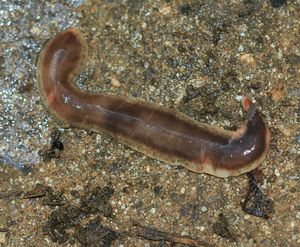New Zealand Flatworm

A. triangulates, also known as the New Zealand flatworm, is a free-living terrestrial flatworm native to New Zealand. This species of flatworm is considered to be an invasive species in several areas of Europe. It is considered an invasive species because of its predation over native earthworms leading to the decline of soil fertility. The leading vector of introduction for this invasive species is thought to be the horticulture and agriculture trade [1]. There is no documented impacts of A. triangulates in its native range of New Zealand.
Scientific Classification

| New Zealand Flatworm | |
|---|---|
| Kingdom: | Metazoa |
| Phylum: | Platyhelminthes |
| Class: | Turbellaria |
| Order: | Tricladida |
| Family: | Geoplanidae |
| Genus: | ''Arthurdendyus'' |
| Species: | ''Arthurdendyus triangulates'' |
Description
Mature Arthurdendyus triangulates can vary in size from 5 to 20cm based on the extension of the body. It has a flattened body that narrows toward the anterior, with no segmentation [2]. The back (dorsal) side of the flatworm is a darker brown color and the underside (ventral) part of the flatworm is a pale tan color. The body of the flatworm is covered in a mucus that can be used to protect the flatworm from desiccation [3]. These flatworms can be found on the surface of the soil, under debris and other objects that are in contact with the soil, or found beneath the soil when hunting for food. the species has the ability to survive without food for long durations of time [4]. The species can move up to 17 meters per hour utilizing trails previously made by earthworms [4]. They move using circular muscles located beneath the epidermal cells and longitudinal muscles that contract throughout the body.
Reproduction
This species of flatworm is a hermaphrodite where adults reproduce following mutual fertilization [5]. Proceeding fertilization, A. triangulates produces a single egg capsule, shown in figure 2, that starts as a red color before turning black. The capsule itself is shiny, flexible and around 8mm in size containing numerous juvenile flatworms [1]. Studies show that a single flatworm can produce an egg capsule once every 2 weeks[5][6].
Native range
The native range of Arthurdendyus triangulates is the South Island in New Zealand. Its native ecosystem is the southern beech forest soils. In its native range there is no documented effects on native earthworm populations [1]. This species of flatworms can also be found in horticulture soils within its native range such as gardens and plant nurseries [7].
Invasive Species
Arthurdendyus triangulates was first found outside its native range in Belfast, Northern Ireland in the early 1960s. It was thought to have been spread through the ornamental plant trade in both the adult and egg form [3]. The species can now be found in areas of England, Northern Ireland, Scotland, and the Faroe Islands. Modeling suggests that this flatworm species could thrive if their invasive range were to spread into areas of German, Poland, and Sweden [8].
Once introduced into this new range Arthurdendyus triangulates is shown to reduce the population size and diversity of native earthworm species, specifically Lumbricus terrestris[9]. This sepcies uses secreted muscus to assist with the digestion of the earthworm. This depletion of earthworm biodiversity reduces the soil quality by eliminating the decomposition service provided by the earthworms. This has an impact on agricultural services by reducing soil fertility.
References
[1] Blackshaw RP; Stewart VI, 1992. Artioposthia triangulata (Dendy, 1894), a predatory terrestrial planarian and its potential impact on lumbricid earthworms. Agricultural Zoology Reviews, 5:201-219; 45 ref.
[2] Saul, W.-C., H. E. Roy, O. Booy, L. Carnevali, H.-J. Chen, P. Genovesi, C. A. Harrower, P. E. Hulme, S. Pagad, J. Pergl, and J. M. Jeschke. 2017. Data from: Assessing patterns in introduction pathways of alien species by linking major invasion databases. Dryad.
[3] Willis R J, Edwards A R, 1977. The occurrence of the land planarian Artioposthia triangulata (Dendy) in Northern Ireland. Irish Naturalists' Journal. 112-116.
[4] Christensen OM; Mather JG, 1995. Colonisation by the land planarian Artioposthia triangulata and impact on lumbricid earthworms at a horticultural site. Pedobiologia, 39(2):144-154.
[5] Baird J; McDowell SDR; Fairweather I; Murchie AK, 2005. Reproductive structures of Arthurdendyus triangulatus (Dendy): seasonality and the effect of starvation. Pedobiologia, 49(5):435-442. http://www.sciencedirect.com/science/journal/00314056
[6] Christensen, O. M. and Mather, J. G. (2001). Long-term study of growth in the New Zealand flatworm Arthurdendyus triangulatus under laboratory conditions. Pedobiologia, 45(6), 535-549.
[7] Johns P M, Boag B, Yeates G W, 1998. Observations on the geographic distribution of flatworms (Turbellaria: Rhynchodemidae, Bipaliidae, Geoplanidae) in New Zealand. Pedobiologia. 469-476.
[8] Boag B; Evans KA; Yeates GW; Johns PM; Neilson R, 1995. Assessment of the global potential distribution of the predatory land planarian Artioposthia triangulata (Dendy) (Tricladida, Terricola) from ecoclimatic data. New Zealand Journal of Zoology, 22:311-318.
[9] Blackshaw RP, 1990. Studies on Artioposthia triangulata (Dendy) (Tricladida: Terricola), a predator of earthworms. Annals of Applied Biology, 116(1):169-176; 6 ref.
[10] How to Live with Flatworm in a Permaculture Garden - Rubha Phoil and Earth Ways. (n.d.). . https://www.earth-ways.co.uk/how-to-live-with-flatworm-in-a-permaculture-garden/#.YIdEY-hKg2w.
[11] By Flickr user Rae's - https://www.flickr.com/photos/35142635@N05/15390553766/in/set-72157647844789000, CC BY 2.0, https://commons.wikimedia.org/w/index.php?curid=39818346